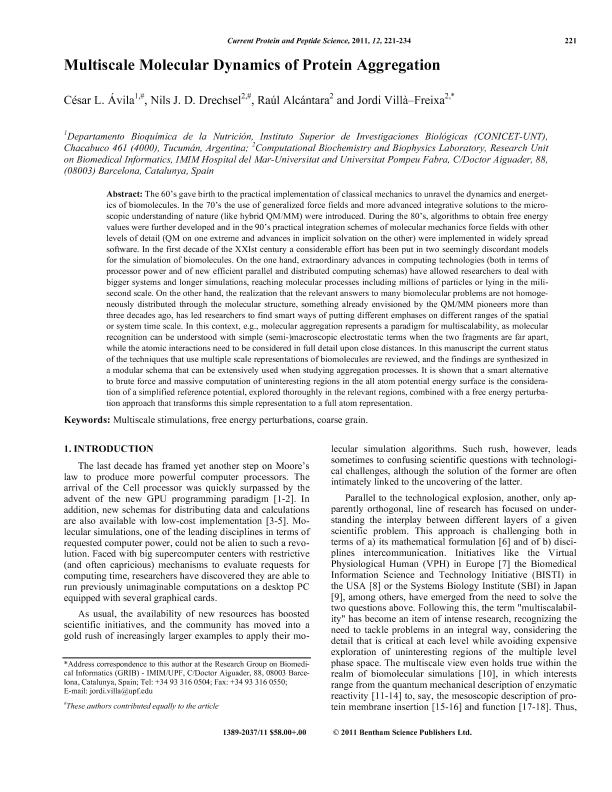Mostrar el registro sencillo del ítem
dc.contributor.author
Avila, Cesar Luis

dc.contributor.author
Dreschel, Nils J. D.
dc.contributor.author
Alcántara, Raúl
dc.contributor.author
Villà Freixa, Jordi
dc.date.available
2018-10-22T20:46:35Z
dc.date.issued
2011-05
dc.identifier.citation
Avila, Cesar Luis; Dreschel, Nils J. D.; Alcántara, Raúl; Villà Freixa, Jordi; Multiscale molecular dynamics of protein aggregation; Bentham Science Publishers; Current Protein and Peptide Science; 12; 3; 5-2011; 221-234
dc.identifier.issn
1389-2037
dc.identifier.uri
http://hdl.handle.net/11336/62885
dc.description.abstract
The 60's gave birth to the practical implementation of classical mechanics to unravel the dynamics and energetics of biomolecules. In the 70's the use of generalized force fields and more advanced integrative solutions to the microscopic understanding of nature (like hybrid QM/MM) were introduced. During the 80's, algorithms to obtain free energy values were further developed and in the 90's practical integration schemes of molecular mechanics force fields with other levels of detail (QM on one extreme and advances in implicit solvation on the other) were implemented in widely spread software. In the first decade of the XXIst century a considerable effort has been put in two seemingly discordant models for the simulation of biomolecules. On the one hand, extraordinary advances in computing technologies (both in terms of processor power and of new efficient parallel and distributed computing schemas) have allowed researchers to deal with bigger systems and longer simulations, reaching molecular processes including millions of particles or lying in the milisecond scale. On the other hand, the realization that the relevant answers to many biomolecular problems are not homogeneously distributed through the molecular structure, something already envisioned by the QM/MM pioneers more than three decades ago, has led researchers to find smart ways of putting different emphases on different ranges of the spatial or system time scale. In this context, e.g., molecular aggregation represents a paradigm for multiscalability, as molecular recognition can be understood with simple (semi-)macroscopic electrostatic terms when the two fragments are far apart, while the atomic interactions need to be considered in full detail upon close distances. In this manuscript the current status of the techniques that use multiple scale representations of biomolecules are reviewed, and the findings are synthesized in a modular schema that can be extensively used when studying aggregation processes. It is shown that a smart alternative to brute force and massive computation of uninteresting regions in the all atom potential energy surface is the consideration of a simplified reference potential, explored thoroughly in the relevant regions, combined with a free energy perturbation approach that transforms this simple representation to a full atom representation.
dc.format
application/pdf
dc.language.iso
eng
dc.publisher
Bentham Science Publishers

dc.rights
info:eu-repo/semantics/openAccess
dc.rights.uri
https://creativecommons.org/licenses/by-nc-sa/2.5/ar/
dc.subject
Coarse Grain
dc.subject
Free Energy Perturbations
dc.subject
Multiscale Stimulations
dc.subject.classification
Otras Ciencias Biológicas

dc.subject.classification
Ciencias Biológicas

dc.subject.classification
CIENCIAS NATURALES Y EXACTAS

dc.subject.classification
Ciencias de la Computación

dc.subject.classification
Ciencias de la Computación e Información

dc.subject.classification
CIENCIAS NATURALES Y EXACTAS

dc.title
Multiscale molecular dynamics of protein aggregation
dc.type
info:eu-repo/semantics/article
dc.type
info:ar-repo/semantics/artículo
dc.type
info:eu-repo/semantics/publishedVersion
dc.date.updated
2018-10-17T15:05:18Z
dc.journal.volume
12
dc.journal.number
3
dc.journal.pagination
221-234
dc.journal.pais
Países Bajos

dc.journal.ciudad
Oak Park
dc.description.fil
Fil: Avila, Cesar Luis. Consejo Nacional de Investigaciones Científicas y Técnicas. Centro Científico Tecnológico Conicet - Tucumán. Instituto Superior de Investigaciones Biológicas. Universidad Nacional de Tucumán. Instituto Superior de Investigaciones Biológicas; Argentina
dc.description.fil
Fil: Dreschel, Nils J. D.. Universitat Pompeu Fabra; España
dc.description.fil
Fil: Alcántara, Raúl. Universitat Pompeu Fabra; España
dc.description.fil
Fil: Villà Freixa, Jordi. Universitat Pompeu Fabra; España
dc.journal.title
Current Protein and Peptide Science

dc.relation.alternativeid
info:eu-repo/semantics/altIdentifier/url/http://www.ncbi.nlm.nih.gov/pubmed/21348836
dc.relation.alternativeid
info:eu-repo/semantics/altIdentifier/doi/https://doi.org/10.2174/138920311795860205
Archivos asociados
